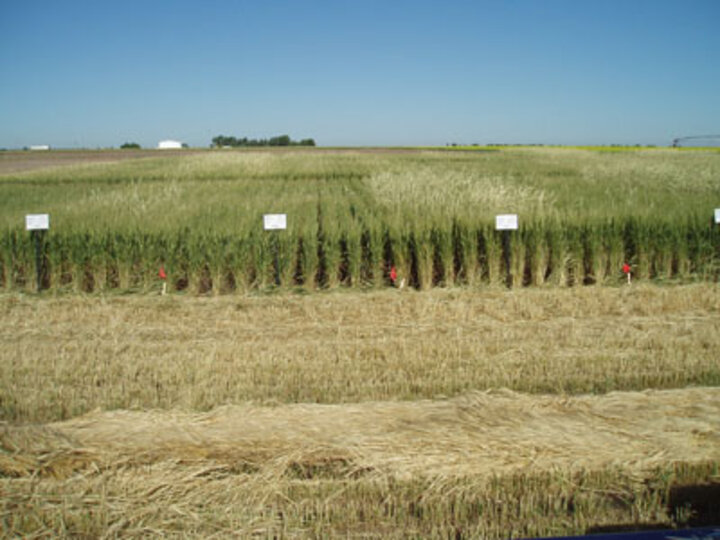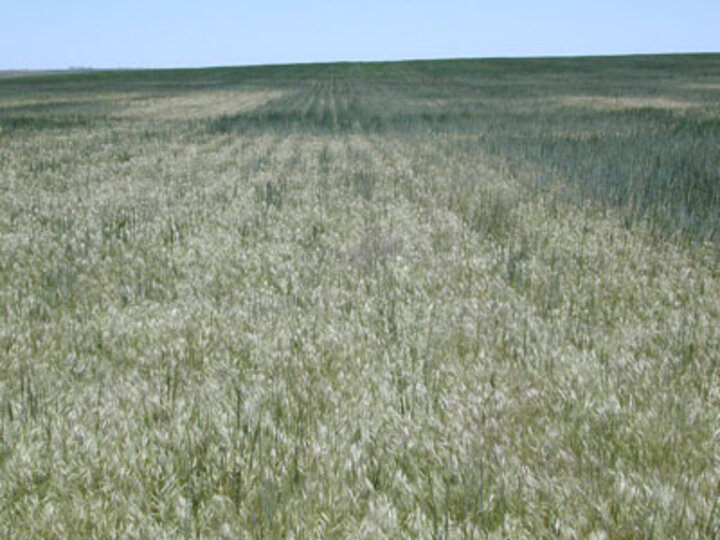August 8, 2008
Downy brome, jointed goatgrass, and feral rye are winter annual grass weeds that are very competitive with winter wheat because they compete with the crop throughout the growing season. Additionally, jointed goatgrass and feral rye may cause dockage and/or foreign material discounts when contaminated grain is delivered to the elevator. In order to minimize losses, growers must control these weeds in a timely manner.

|
| Feral rye in winter wheat herbicide trials. |

|
| A weed control check strip with a high population of downy brome in winter wheat. |
Only in the last several years has it been possible to selectively control winter annual grass weeds in winter wheat. Control of these weeds is best when herbicides are applied in the fall, shortly after emergence, when the plants are growing rapidly but before they become well tillered. Winter wheat fields that look like a lawn probably have winter annual grassy weeds filling in between the rows of wheat.
Chemical Control
Maverick®, Olympus™, Olympus™ Flex, and PowerFlex™ herbicides provide selective control of downy brome, and other Bromus species, in winter wheat. All four products provide very similar control of downy brome when applied in the fall. Downy brome control with fall applications has ranged from about 70% to 95% in UNL trials. Spring applications have been less consistent and have ranged from 30% to 80% control. Plant growth rate and development stage at the time of application, and weather conditions following application influence control. Maverick has not performed quite as well as the other products when applied in spring.
Maverick, Olympus, Olympus Flex, and PowerFlex all have significant soil residual concerns that restrict crop rotation options. Olympus Flex has a little less soil residual than Olympus, which allows a few rotational crops to be planted a little sooner than is the case with Olympus, but the differences are small and may be of little practical significance in Nebraska. PowerFlex has the shortest recrop intervals, with most crops approved for planting nine months after application.
Clearfield Wheat
Growers who have seeded a Clearfield wheat variety can use Beyond™ herbicide to selectively control downy brome, jointed goatgrass, and feral rye. Of these three weeds, feral rye control has proven to be the most difficult and least consistent. The best control of feral rye has been achieved by applying 5 oz/ac of Beyond in the early fall before rye plants have formed a tiller. It is recommended that UAN and surfactant be added to the spray mixture for improved control. In UNL trials, fall control of feral rye with Beyond has ranged from 70% to 90%. Some growers have reported very poor control while others have been happy with the level of control. Control of feral rye with spring applications of Beyond has been inconsistent and is not advised in most situations.
Unlike feral rye, the control of jointed goatgrass with Beyond has been very good and consistent. Fall and spring applications of Beyond at 4 oz/ac have generally ranged from 85% to 100% control. Surfactant and UAN should be added to the spray mixture. Herbicide resistance is a concern with jointed goatgrass, so growers should not overuse this technology or it may soon lose its usefulness. We recommend that growers not use Beyond herbicide more than twice in six years.
Although downy brome control with Beyond is usually good, downy brome can be controlled more economically with the previously discussed herbicides. Feral rye also may be controlled with glyphosate and a rope-wick applicator. The rye should be 10 to 12 inches taller than the wheat for best results. This is easier to achieve with wheat varieties that are short to medium in plant height. In heavy stands of rye, travel in both directions. Remember that if you contact the wheat with the rope-wick or drip the herbicide on the crop, it will cause injury. The glyphosate should be mixed at a 33% concentration or 1 gallon of herbicide with 2 gallons of water. Surfactants may be needed for some glyphosate formulations.
Control Through Crop Rotation
If winter annual grass weeds are a regular problem in fields, change the crop rotation. Including a spring-seeded crop such as corn, sorghum, oat, proso millet, or sunflower in the rotation with winter wheat and fallow provides an additional year in which to prevent seed production and allows the soil seed bank to gradually decrease. Late spring-seeded crops are more effective than early-seeded crops in reducing problems with winter annual grass weeds. Additional information on controlling these three winter annual grasses in winter wheat is available online in the Wheat Production Systems Handbook.
Drew Lyon, Extension Dryland Cropping Systems Specialist
Panhandle REC, Scottsbluff
Robert Klein, Extension Cropping Systems Specialist
West Central REC, North Platte
